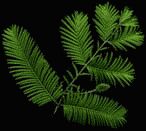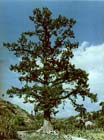Conservation Status

Metasequoia glyptostroboides
Hu et Cheng 1948
Common names
Dawn redwood, water fir, water larch; 水杉 shui shan [Chinese] (literally, water fir); メタセコイア [Japanese].
Taxonomic notes
The sole species in Metasequoia S. Miki 1941, a genus initially described from fossil material (see Remarks).
Synonyms: Metasequoia glyptostroboides Hu & W.C. Cheng var. caespitosa Y.H. Long & Y. Wu 1984; M. glyptostroboides Hu & W.C. Cheng subsp. caespitosa (Y.H. Long & Y. Wu) Silba 2010.
Description
Monoecious, deciduous trees to 45 m tall and 250 cm dbh, commonly with a tapering trunk, a broad and often buttressed base, and a conical crown of ascending branches that becomes rounded or irregular with age; often, there are several trunks, or trunks of closely-spaced trees have fused as they grow larger. Bark fibrous, reddish brown, becoming fissured and darkening to gray with age, exfoliating in long, narrow strips. Twigs glabrous, reddish-brown, shallowly ridged. Buds non-resinous, opposite, ovoid or ellipsoid, 2.5-5 × 1.3-3 mm; scales light reddish- or yellowish-brown, ovate, with a linear keel. Foliage borne in opposite cladodes 3-8 cm long, each with a pectinate array of ca. 50 leaves, each ca. 1.6 × 12 mm (larger on young plants), linear, flattened, straight or slightly curved, obtuse or short-mucronate, tapering abruptly to a decurrent base, adaxially bright green with a narrowly grooved midvein, abaxially light green with faint stomatal lines and a slightly raised midrib; deciduous, turning reddish-brown before falling. Pollen cones ovoid, ca. 5 mm long, numerous, decussate on long spikes or panicles. Seed cones terminal, solitary, pendulous, sub-globose or shortly cylindrical, up to 25 mm long, comprised of 20-30 woody scales in decussate pairs, the upper 3 pairs and the lower 2-3 pairs sterile, the fertile scales each bearing (2-)5-8(-9) ovules, the outer surface of the scale transverse-elliptic or broad-triangular, with a horizontal groove. Seed light brown, usually obovate, 5 mm long, with 2 broad, thin, paler wings. Cotyledons usually 2. Diploid: 2n=22 (Dallimore et al. 1967 and pers. obs.). See García Esteban et al. (2004) for a detailed characterization of the wood anatomy.
There are three deciduous genera in the Cupressaceae: Glyptostrobus, Metasequoia, and Taxodium. The first two are endemic to small areas in China, so they are rarely seen except in cultivation. The latter two are common in cultivation within warm-temperate areas of the world, and they are most easily distinguished by the cladodes, which are opposite in Metasequoia but alternate in Taxodium. Glyptostrobus, rarely seen except in botanical gardens, has very distinctive pear-shaped seed cones with about 20 imbricate scales.
Distribution and Ecology
China: Primary occurrence near the Sichuan-Hubei border, ca. 30°10'N, 108°45'E, with an outlying occurrence in NW Hunan; at 750-1500 m elevation (Raven et al. 1986, Silba 1986). E Sichuan, SW Hubei, NW Hunan, at 750-1500 m elevation (Silba 1986). Hardy to Zone 5 (cold hardiness limit between -28.8°C and -23.3°C) (Bannister and Neuner 2001).
Typically found on shady, moist sites such as ravines and stream banks. The species was discovered by a Chinese forester, Gan Duo, when a small population was found in Modaoqi on the Sichuan-Hubei border. One to three of these trees were later sampled to produce the entire seed source for trees grown outside China before 1991. A more detailed exploration in 1947 found the species to range over an area of about 800 km2. The center of population, supporting a population of about 6,000 large trees, was in the nearby Shuishaba valley in Hubei. Much of this population was logged following the Revolution in 1949. In 1986, an outlying population was found in Hunan (Hendricks 1995). The species is, of course, rare and sensitive to human impacts. It is [as of 1980] protected from cutting, but not from habitat degradation, and very few seedlings were observed in 1980 (Bartholomew et al. 1983).
Remarkable Specimens
The type specimen, in Modaoqi, was in 1980 measured at 241 cm diameter in the buttressed portion of the trunk, and 167 cm diameter above the buttress. I believe this is the specimen shown at right. Several trees about 50 m tall are found in the Shuishaba valley. An isolated tree formerly grew a few kilometers to the north at Wangjiaying, 220 cm diameter and 50 m tall; this was the largest tree yet recorded, but was killed by a lightning strike in 1951 (Bartholomew et al. 1983). A visit to the Hubei population in 1980 found stumps over 2 m diameter, logged between 1950 and 1980 (Hendricks 1995).
Although the species was not planted outside its native range until 1948, ornamentals at sites around the world have shown rapid growth since then. The arborist at Longwood Gardens in Kennett Square, Pennsylvania reports two trees that are, respectively, 41.5 m tall and 186 cm dbh (Scott Wade email 2021.06.30). Older measurements include a tree measured in 2010 at 28 m tall and 167 cm dbh near New Plymouth, New Zealand (New Zealand Notable Trees); and a tree 36.9 m tall with a dbh of 135 cm at the College of William and Mary, Williamsburg, Virginia (Robert Van Pelt e-mail 1998.03.18). The botanical garden at the University of California, Berkeley, has a tree 174 cm dbh and a neighboring one 39.0 m tall (Robert Van Pelt e-mail 2023.10.06).
The oldest confirmed ages are for trees planted in the US in 1948. The size of subfossil remnants in China (above) suggests ages of at least 100 years, and ages of 300 and 450 years have been mentioned based on extrapolations from partial cores (Bartholomew et al. 1983).
Ethnobotany
At the time of its discovery, it was commonly planted as an ornamental by the local people (Dallimore et al. 1967), and has since become a very popular tree, with several million trees (mostly rooted cuttings) planted in China each year. It is also a popular ornamental in the West. Nearly all trees now growing outside China are from seed stock derived from one to three Chinese trees during 1947 collections. In 1983 it was noted that this Western stock suffers from inbreeding depression, and in 1990-91 extensive collection of seed were made in China, allowing provenance testing to be conducted at several sites in the West, notably the Dawes Arboretum (Hendricks 1995). However, the 1948 trees were evaluated for their timber potential, and results were not promising. Although fluting of the trunk can be minimized by pruning the lower branches, the trees are shade intolerant compared to similar species such as Sequoia, and the wood is brittle (Kuser 1998).
Observations
The Arnold Arboretum (Boston, Massachusetts, USA), which was largely responsible for introducing this species to the world (Merrill 1948), has a large grove planted at that time. I visited the grove in 2022 and it is now quite an impressive stand, though larger trees can be found elsewhere. Specimens from the 1948 plantings can be found in nearly every major arboretum and botanical garden in the temperate to subtropical climes of the globe. In general, those planted in aquatic settings such as wetlands or riparian areas have shown the best performance and make the most impressive plants.
Remarks
Few conifers have been introduced to cultivation with as much fanfare as Metasequoia; its introduction to the U.S. and Europe was a major media event, perhaps because of the association between this species and two other much-loved cypresses, Sequoia and Sequoiadendron. The interested reader is urged to peruse Merrill (1948), which delivers a contemporary account, and also the 1998 issue of Arnoldia (accessed 2023.10.12), which was devoted to a retrospective on the introduction of Metasequoia.
Citations
Bartholomew, B., D.E. Boufford and S.A. Spongberg. 1983. Metasequoia glyptostroboides -- its present status in central China. Journal of the Arnold Arboretum 64:105-128. Available: Biodiversity Heritage Library, accessed 2021.12.19.
Hendricks, Donald R. 1995. Metasequoia: depression, sex, and other useful information. Landscape Plant News 6(2), pagination unknown. Published online at http://www.airnet.net/redwood/rwmeta.html, accessed 1999.04.12, now defunct.
Hu and Cheng. 1948. Bulletin Fan Memorial Institute of Biology 1 (2):153-161.
Kuser, John E. 1998. Metasequoia glyptostroboides: fifty years of growth in North America. Arnoldia 58(4):76-79. Available: arnoldia.arboretum.harvard.edu/pdf/articles/523.pdf, accessed 2010.04.11.
Long, Y. H. and Y. Wu. 1984. Bulletin of Botanical Research, Harbin 4(1):149.
Merrill, E.D. 1948. Metasequoia, another 'living fossil'. Arnoldia 8(1). Available: Biodiversity Heritage Library, accessed 2021.12.19.
Raven, Peter H., Ray F. Evert and Susan E. Eichhorn. 1986. Biology of Plants, 4th ed. New York: Worth. 774 p.
Silba, J. 2010. Journal of the International Conifer Preservation Society 17(1):25.
See also
The species account at Threatened Conifers of the World.
Ahuja, M.R. 2009. Genetic constitution and diversity in four narrow endemic redwoods from the family Cupressaceae. Euphytica 165:5-19.
Bartholomew, B. 1981. "Plant Collecting in China;" University of California Berkeley Botanical Garden Quarterly.
Chaney. 1950. Yearbook of the Carnegie Institution of Washington 49:114-116.
Chaney. 1951. Transactions of the American Philosophical Society 40(3):171-262.
Chu Kwei-Ling and William S. Cooper. 1950. An ecological reconnaissance in the native home of
Metasequoia glyptostroboides. Ecology 31 (2):260-278. Reprinted in Arnoldia, 1998; available: arnoldia.arboretum.harvard.edu/pdf/articles/517.pdf, accessed 2010.04.11.
Farjon 2005.
Florin. 1952. Bot. Notiser 1:29.
Gittlen, W. 1999. Discovered Alive: The Story of the Chinese Redwood. Pierside.
Hu. 1948. Journal of the New York Botanical Garden 49(585):201-207.
Hendricks, Donald R. 1993. Dawn-redwood research. The Dawes Arboretum Newsletter 28(10).
Hsueh Chi-ju. 1985. Reminiscences of collecting the type specimens of Metasequoia glyptostroboides. Arnoldia 45(4).
Kuser, John E. 1982. Metasequoia keeps on growing. Arnoldia 42(3).
Kuser, John E. 1983. Inbreeding depression in Metasequoia. Journal of the Arnold Arboretum 64:475-481. Available: Biodiversity Heritage Library, accessed 2021.12.19.
Kuser, John E. 1990. China's living fossil. The World & I Jan/Feb.
Kuser, John E., D.L. Sheely, and D.R. Hendricks. 1997. Genetic variation in
two ex situ collections of the rare Metasequoia glyptostroboides (Cupressaceae). Silvae Genetica 46:258-264.
Li, J. 1999. Metasequoia: an overview of its phylogeny, reproductive
biology, and ecotypic variation. Arnoldia 59:54-59.
Li Y.Y., Chen X.Y., Zhang X., Wu T.Y., Lu H.P., and Cai Y.W. 2005. Genetic differences between wild and artificial populations of Metasequoia glyptostroboides: implications of species
recovery. Conservation Biology 19:224-231.
Miki Shigeru. 1941. Japanese Journal of Botany 11:237-303.
Mitchell. 1964. Journal of the Royal Horticultural Society 89(11):468-469.
Sand, Susan. 1996. The dawn redwood. American Conifer Society Bulletin 13(1): 2-6.






